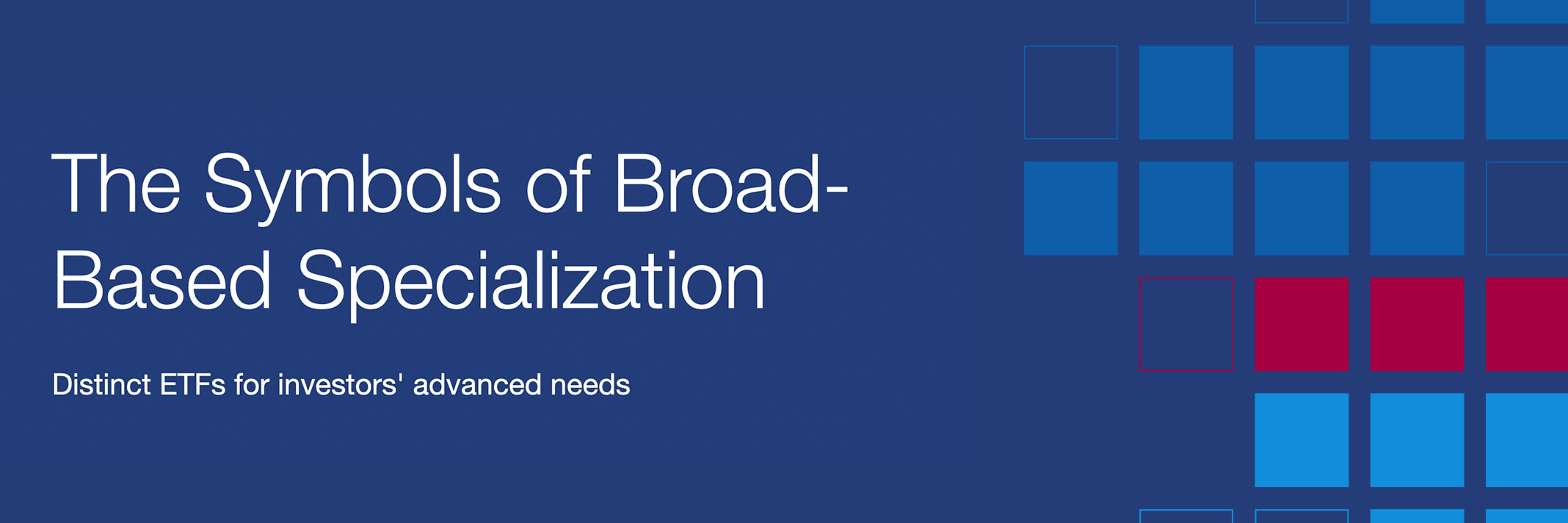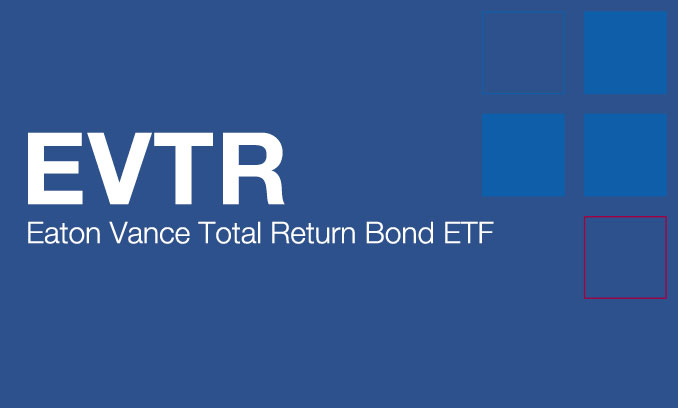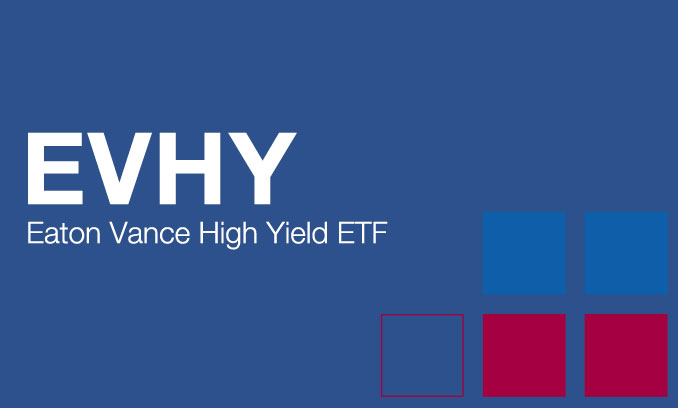Differentiated ETF Solutions
All of our strategies feature thoughtfully designed and expertly built exposures designed to meet specific investor goals, including income generation, management of downside risk, capital appreciation and tax efficiency.
Eaton Vance Total Return Bond ETF
Seeks above-average total return over a market cycle of three to five years.
Eaton Vance High Yield ETF
Seeks to provide a high level of current income. The Fund’s secondary objectives are to seek growth of income and capital.
Parametric Equity Premium Income ETF
Seeks to provide consistent monthly income while maintaining prospects for capital appreciation.
Calvert US Large-Cap Core Responsible Index ETF
Seeks to track the performance of the Calvert US Large-Cap Core Responsible Index.
Market Outlooks
Floating-Rate Loan Market Monitor
Learn about the loan market, get updates on loan market conditions and explain the role of loans within portfolios.
Navigating the Curve
Access our wide range of actively managed fixed income funds, including short, intermediate and credit plus strategies.
Corporate Bond Market Insight
Our corporate bond specialists look back at the market’s performance and provide incisive commentary to help you make sense of what drove the market—and what may be on the horizon for fixed income investors.
Quick Links
Insights
Timely insights on the issues that matter most to advisors and their clients
Videos
Manager Update:
Eaton Vance Total Return Bond ETF
Manager Update:
Eaton Vance High Yield ETF
Manager Update: Eaton Vance Short Duration Municipal ETF
Manager Update: Eaton Vance Intermediate Municipal Income ETF
Social
Important Risks and ETF Information
Eaton Vance Total Return Bond ETF (EVTR) There is no assurance that a portfolio will achieve its investment objective. Portfolios are subject to market risk, which is the possibility that the market values of securities owned by the portfolio will decline. Market values can change daily due to economic and other events (e.g. natural disasters, health crises, terrorism, conflicts and social unrest) that affect markets, countries, companies or governments. It is difficult to predict the timing, duration, and potential adverse effects (e.g. portfolio liquidity) of events. Accordingly, you can lose money investing in this portfolio. Please be aware that this portfolio may be subject to certain additional risks. Fixed-income securities are subject to the ability of an issuer to make timely principal and interest payments (credit risk), changes in interest rates (interest-rate risk), the creditworthiness of the issuer and general market liquidity (market risk). In a rising interest-rate environment, bond prices may fall and may result in periods of volatility and increased portfolio redemptions. In a declining interest-rate environment, the portfolio may generate less income. Longer-term securities may be more sensitive to interest rate changes. Mortgage and asset-backed securities are sensitive to early prepayment risk and a higher risk of default and may be hard to value and difficult to sell (liquidity risk). They are also subject to credit, market and interest rate risks. Collateralized loan obligations carry additional risks such as the Fund may invest in CLOs that are subordinate to other classes and the complex structure may not be fully understood at the time of investment and may produce disputes with the issuer or unexpected investment results. When-Issued Securities, Delayed Delivery Securities, TBAs and Forward Commitments These investments may result in a form of leverage and may increase volatility in the Fund’s share price. They are subject to risks such as failure of the counterparty to perform its obligation to deliver the security, the characteristics of a security delivered to the Fund may be less favorable than expected and the security the Fund buys will lose value prior to its delivery. Derivative instruments may disproportionately increase losses and have a significant impact on performance. They also may be subject to counterparty, liquidity, valuation, correlation and market risks. Due to the possibility that prepayments will alter the cash flows on Collateralized mortgage obligations (CMOs), it is not possible to determine in advance their final maturity date or average life. In addition, if the collateral securing the CMOs or any third party guarantees are insufficient to make payments, the strategy could sustain a loss. Certain U.S. government securities purchased by the portfolio, such as those issued by Fannie Mae and Freddie Mac, are not backed by the full faith and credit of the U.S. It is possible that these issuers will not have the funds to meet their payment obligations in the future. Illiquid securities may be more difficult to sell and value than publicly traded securities (liquidity risk). High yield securities (“junk bonds”) are lower rated securities that may have a higher degree of credit and liquidity risk. Foreign securities are subject to currency, political, economic and market risks. Investments in foreign markets entail special risks such as currency, political, economic, market and liquidity risks. In emerging countries, these risks may be more significant. The portfolio may engage in active and frequent trading of its portfolio securities. A high portfolio turnover rate could result in high brokerage costs and an increase in taxable capital gains distributions. Preferred securities are subject to interest rate risk and generally decreases in value if interest rates rise and increase in value if interest rates fall. Active Management Risk. In pursuing the Fund’s investment objective, the Adviser has considerable leeway in deciding which investments to buy, hold or sell on a day-to-day basis, and which trading strategies to use. For example, the Adviser, in its discretion, may determine to use some permitted trading strategies while not using others. The success or failure of such decisions will affect the Fund’s performance. Participant Concentration Risk. The Portfolio has a limited number of intermediaries that act as authorized participants and none of these authorized participants is or will be obligated to engage in creation or redemption transactions. As a result, shares may trade at a discount to net asset value (“NAV”) and possibly face trading halts and/or delisting. Trading Risk. The market prices of Shares are expected to fluctuate, in some cases materially, in response to changes in the Portfolio’s NAV, the intra-day value of holdings, and supply and demand for Shares. The Adviser cannot predict whether Shares will trade above, below or at their NAV. Buying or selling Shares in the secondary market may require paying brokerage commissions or other charges imposed by brokers as determined by that broker.
Eaton Vance Floating-Rate ETF (EVLN) There is no assurance that a portfolio will achieve its investment objective. Portfolios are subject to market risk, which is the possibility that the market values of securities owned by the portfolio will decline. Market values can change daily due to economic and other events (e.g. natural disasters, health crises, terrorism, conflicts and social unrest) that affect markets, countries, companies or governments. It is difficult to predict the timing, duration, and potential adverse effects (e.g. portfolio liquidity) of events. Accordingly, you can lose money investing in this portfolio. Please be aware that this portfolio may be subject to certain additional risks. Loans are generally associated with fixed income securities risk and are traded in a private, unregulated inter-dealer or inter-bank resale market and are generally subject to contractual restrictions that must be satisfied before a loan can be bought or sold. These restrictions may impede the Fund’s ability to buy or sell loans (thus affecting their liquidity) and may negatively impact the transaction price. It may take longer than seven days for transactions in loans to settle; therefore the Fund may hold cash, sell investments or temporarily borrow from banks or other lenders to meet short-term liquidity needs. Loans to entities located outside of the U.S. may have substantially different lender protections and covenants as compared to loans to U.S. entities and may involve greater risks. Loans may be structured such that they are not securities under securities law, and in the event of fraud or misrepresentation by a borrower, lenders may not have the protection of the anti-fraud provisions of the federal securities laws. Loans are also subject to risks associated with other types of income investments. Fixed-income securities are subject to the ability of an issuer to make timely principal and interest payments (credit risk), changes in interest rates (interest-rate risk), the creditworthiness of the issuer and general market liquidity (market risk). In a rising interest-rate environment, bond prices may fall and may result in periods of volatility and increased portfolio redemptions. In a declining interest-rate environment, the portfolio may generate less income. In addition to fixed income securities risk, asset-backed securities are subject to the risk that various federal and state consumer laws and other legal and economic factors may result in the collateral backing the securities being insufficient to support payment on the securities. Some also entail prepayment risk and extension risk, and may become more volatile in certain interest rate environment. Collateralized loan obligations carry additional risks such as the Fund may invest in CLOs that are subordinate to other classes and the complex structure may not be fully understood at the time of investment and may produce disputes with the issuer or unexpected investment results. Distressed and defaulted securities are speculative and involve substantial risks in addition to the risks of investing in high yield securities, which are lower rated securities that may have a higher degree of credit and liquidity risk. The Fund will generally not receive interest payments on the distressed securities and the repayment of principal may also be at risk. These securities may present a substantial risk of default or may be in default at the time of investment, requiring the Fund to incur additional costs. Mezzanine investments are subordinated debt securities, thus they carry the risk that the issuer will not be able to meet its obligations and that the mezzanine investments may lose value. Investments in foreign markets entail special risks such as currency, political, economic, and market risks. The risks of investing in emerging market countries are greater than the risks generally associated with investments in foreign developed countries. Currency fluctuations could erase investment gains or add to investment losses. Illiquid securities may be more difficult to sell and value than publicly traded securities (liquidity risk). Derivative instruments may disproportionately increase losses and have a significant impact on performance. They also may be subject to counterparty, liquidity, valuation, correlation and market risks. Portfolio Turnover. Consistent with its investment policies, the Fund will purchase and sell securities without regard to the effect on portfolio turnover. Higher portfolio turnover will cause the Fund to incur additional transaction costs. Active Management Risk. In pursuing the Portfolio’s investment objective, the Adviser has considerable leeway in deciding which investments to buy, hold or sell on a day-to-day basis, and which trading strategies to use. The success or failure of such decisions will affect performance. ETF Structure Risks. Authorized Participant Concentration Risk. The Portfolio has a limited number of intermediaries that act as authorized participants and none of these authorized participants is or will be obligated to engage in creation or redemption transactions. As a result, shares may trade at a discount to net asset value (“NAV”) and possibly face trading halts and/or delisting. Cash Transactions Risk. Unlike certain ETFs, the Fund may effect creations and redemptions in cash or partially in cash. Therefore, it may be required to sell portfolio securities and subsequently recognize gains on such sales that the Fund might not have recognized if it were to distribute portfolio securities in-kind. As such, investments in shares may be less tax-efficient. Trading Risk. The market prices of Shares are expected to fluctuate, in some cases materially, in response to changes in the Portfolio’s NAV, the intra-day value of holdings, and supply and demand for Shares. The Adviser cannot predict whether Shares will trade above, below or at their NAV. may pay significantly more or receive significantly less than the Fund’s NAV per share during periods when there is a significant premium or discount. Buying or selling Shares in the secondary market may require paying brokerage commissions or other charges imposed by brokers as determined by that broker. New Fund Risk. A new portfolio’s performance may not represent how the portfolio is expected to or may perform in the long term. In addition, there is a limited operating history for investors to evaluate and the portfolio may not attract sufficient assets to achieve investment and trading efficiencies.
Eaton Vance High Yield ETF (EVHY) Diversification does not eliminate risk of loss. There is no assurance that a portfolio will achieve its investment objective. Portfolios are subject to market risk, which is the possibility that the market values of securities owned by the portfolio will decline. Market values can change daily due to economic and other events (e.g. natural disasters, health crises, terrorism, conflicts and social unrest) that affect markets, countries, companies or governments. It is difficult to predict the timing, duration, and potential adverse effects (e.g. portfolio liquidity) of events. Accordingly, you can lose money investing in this portfolio. Please be aware that this portfolio may be subject to certain additional risks. Active Management Risk. In pursuing the Fund’s investment objective, the Adviser has considerable leeway in deciding which investments to buy, hold or sell on a day-to-day basis, and which trading strategies to use. For example, the Adviser, in its discretion, may determine to use some permitted trading strategies while not using others. The success or failure of such decisions will affect the Fund’s performance. Fixed-income securities are subject to the ability of an issuer to make timely principal and interest payments (credit risk), changes in interest rates (interest-rate risk), the creditworthiness of the issuer and general market liquidity market risk). In a rising interest-rate environment, bond prices may fall and may result in periods of volatility and increased portfolio redemptions. In a declining interest-rate environment, the portfolio may generate less income. Longer-term securities may be more sensitive to interest rate changes. High yield securities (“junk bonds”) are lower rated securities that may have a higher degree of credit and liquidity risk. Preferred securities are subject to interest rate risk and generally decreases in value if interest rates rise and increase in value if interest rates fall. Foreign securities are subject to currency, political, economic and market risks. The risks of investing in emerging market countries are greater than risks associated with investments in foreign developed countries. Illiquid securities may be more difficult to sell and value than publicly traded securities (liquidity risk). Derivative instruments may disproportionately increase losses and have a significant impact on performance. They also may be subject to counterparty, liquidity, valuation, correlation and market risks. By investing in investment company securities, the portfolio is subject to the underlying risks of that investment company’s portfolio securities. In addition to the Portfolio’s fees and expenses, the Portfolio generally would bear its share of the investment company’s fees and expenses. New Fund Risk. A new portfolio’s performance may not represent how the portfolio is expected to or may perform in the long term. In addition, there is a limited operating history for investors to evaluate and the portfolio may not attract sufficient assets to achieve investment and trading efficiencies. Authorized Participant Concentration Risk. The Portfolio has a limited number of intermediaries that act as authorized participants and none of these authorized participants is or will be obligated to engage in creation or redemption transactions. As a result, shares may trade at a discount to net asset value (“NAV”) and possibly face trading halts and/or delisting. Trading Risk. The market prices of Shares are expected to fluctuate, in some cases materially, in response to changes in the Portfolio’s NAV, the intra-day value of holdings, and supply and demand for Shares. The Adviser cannot predict whether Shares will trade above, below or at their NAV. Buying or selling Shares in the secondary market may require paying brokerage commissions or other charges imposed by brokers as determined by that broker.
Parametric Equity Premium Income ETF (PAPI) Diversification does not eliminate risk of loss. There is no assurance that a fund will achieve its investment objective. Funds are subject to market risk, which is the possibility that the market values of securities owned by the fund will decline. Market values can change daily due to economic and other events (e.g. natural disasters, health crises, terrorism, conflicts and social unrest) that affect markets, countries, companies or governments. It is difficult to predict the timing, duration, and potential adverse effects (e.g. portfolio liquidity) of events. Accordingly, you can lose money investing in this fund. Please be aware that this fund may be subject to certain additional risks. In general, equities securities’ values also fluctuate in response to activities specific to a company. Income Risk. The Fund’s ability to distribute income to shareholders will depend on the yield available on the equity securities held by the Fund and the premiums received by the Fund with respect to its written call options. The amount of the Fund’s distributions for any period may exceed the amount of the Fund’s income and gains for that period. In that case, some or all of the Fund’s distributions may constitute a return of capital to shareholders. Call Option Writing Risk. Writing call options involves the risk that the Fund may be required to sell the underlying security or instrument (or settle in cash an amount of equal value) at a disadvantageous price or below the market price of such underlying security or instrument, at the time the option is exercised. As the writer of a call option, the Fund forgoes, during the option’s life, the opportunity to profit from increases in the market value of the underlying security or instrument covering the option above the sum of the premium and the exercise price, but retains the risk of loss should the price of the underlying security or instrument decline. Additionally, the Fund’s call option writing strategy may not fully protect it against declines in the value of the market. In rising markets, a fund with a call writing strategy could significantly underperform the same fund without such an options writing strategy. The Fund will also incur a form of economic leverage through its use of call options, which could increase the volatility of the Fund’s returns and may increase the risk of loss to the Fund. There are special risks associated with uncovered option writing which expose the Fund to potentially significant loss. FLEX Options. The Fund utilizes FLEX Options guaranteed for settlement by the Options Clearing Corporation (“OCC”). The Fund bears the risk that the OCC will be unable or unwilling to perform its obligations under the FLEX Options contracts. In the unlikely event that the OCC becomes insolvent or is otherwise unable to meet its settlement obligations, the Fund could suffer significant losses. FLEX Options are subject to the risk that they may be less liquid than certain other securities, such as standardized options. Additionally, in connection with the creation and redemption of Fund shares, to the extent market participants are not willing or able to enter into FLEX Option transactions with the Fund, the Fund’s NAV and, in turn the share price of the Fund, could be negatively impacted. The value of a FLEX Option may not directly correlate to its underlying reference security or index. The Fund may experience losses from certain FLEX Option positions and certain FLEX Option positions may expire with little to no value. Illiquid Securities. The fund may make investments in securities that are or become illiquid or less liquid and which may be more difficult to sell and value (liquidity risk). Derivative instruments may disproportionately increase losses and have a significant impact on performance. They also may be subject to counterparty, liquidity, valuation, correlation and market risks. Active Management Risk. In pursuing the Fund’s investment objective, the adviser and/or subadviser has considerable leeway in deciding which investments to buy, hold or sell on a day-to-day basis, and which trading strategies to use. For example, the adviser and/or subadviser, in its discretion, may determine to use some permitted trading strategies while not using others. The success or failure of such decisions will affect the Fund’s performance. New Fund Risk. A new fund’s performance may not represent how the fund is expected to or may perform in the long term. In addition, there is a limited operating history for investors to evaluate and the fund may not attract sufficient assets to achieve investment and trading efficiencies. Clearing Member Risk. Transactions in some types of derivatives, including FLEX Options, are required to be centrally cleared (“cleared derivatives”). In a transaction involving cleared derivatives, the Fund’s counterparty is a clearing house, such as the OCC, rather than a bank or broker. Since the Fund is not a member of clearing houses and only members of a clearing house (“clearing members”) can participate directly in the clearing house, the Fund will hold cleared derivatives through accounts at clearing members. In cleared derivatives positions, the Fund will make payments to and receive payments from a clearing house through their accounts at clearing members. The Fund is also subject to the risk that a limited number of clearing members are willing to transact on the Fund’s behalf, which heightens the risks associated with a clearing member’s default. If a clearing member defaults, the Fund could lose some or all of the benefits of a transaction entered into by the Fund with the clearing member. The loss of a clearing member for the Fund to transact with could result in increased transaction costs and other operational issues that could impede the Fund’s ability to implement its investment strategy. If the Fund cannot find a clearing member to transact with on the Fund’s behalf, the Fund may be unable to effectively implement its investment strategy. Counterparty. Counterparty risk generally refers to the risk that a counterparty on a derivatives transaction may not be willing or able to perform its obligations under the derivatives contract, and the related risks of having concentrated exposure to such a counterparty. If an OCC clearing member or OCC becomes insolvent, the Fund may have its positions closed or experience delays or difficulties in closing or exercising its FLEX Options positions and the Fund could suffer significant losses. Tax Risk. The Fund intends to limit the overlap between its stock holdings and the stock holdings of the underlying ETF or underlying index of options to less than 70% on an ongoing basis in an effort to avoid being subject to the “straddle rules” under federal income tax law. The Fund expects that the option contracts it writes will not be considered straddles. Under certain circumstances, however, the Fund may enter into options transactions or certain other investments that may constitute positions in a straddle. The straddle rules may affect the character of gains (or losses) realized by the Fund. Authorized Participant Concentration Risk. The Fund has a limited number of intermediaries that act as authorized participants and none of these authorized participants is or will be obligated to engage in creation or redemption transactions. As a result, shares may trade at a discount to net asset value (“NAV”) and possibly face trading halts and/or delisting. Trading Risk. The market prices of shares of the Fund are expected to fluctuate, in some cases materially, in response to changes in the Fund’s NAV, the intra-day value of holdings, and supply and demand for Shares. The Adviser and Subadviser cannot predict whether shares will trade above, below or at their NAV. Buying or selling shares in the secondary market may require paying brokerage commissions or other charges imposed by brokers as determined by that broker.
Calvert, Eaton Vance and Parametric are part of Morgan Stanley Investment Management, the asset management division of Morgan Stanley.
Morgan Stanley Investment Management Inc. is the adviser to the Eaton Vance ETFs, and the Parametric ETFs. Morgan Stanley Investment Management Limited is the sub-adviser to Eaton Vance High Yield ETF. Parametric Portfolio Associates LLC is the sub-adviser to the Parametric ETFs. The ETFs are distributed by Foreside Fund Services, LLC.











